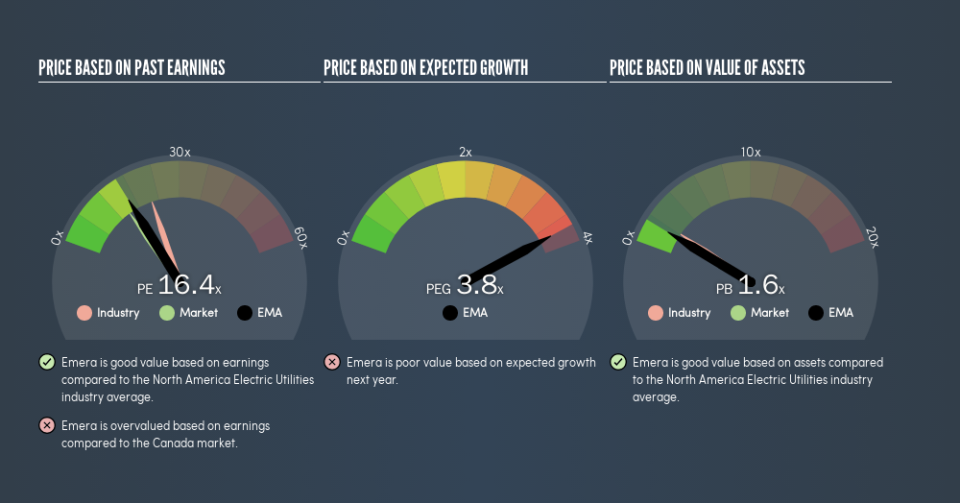Does Emera Incorporated's (TSE:EMA) P/E Ratio Signal A Buying Opportunity?

Want to participate in a research study? Help shape the future of investing tools and earn a $60 gift card!
The goal of this article is to teach you how to use price to earnings ratios (P/E ratios). We'll show how you can use Emera Incorporated's (TSE:EMA) P/E ratio to inform your assessment of the investment opportunity. Emera has a P/E ratio of 16.4, based on the last twelve months. That means that at current prices, buyers pay CA$16.4 for every CA$1 in trailing yearly profits.
Check out our latest analysis for Emera
How Do You Calculate Emera's P/E Ratio?
The formula for price to earnings is:
Price to Earnings Ratio = Price per Share ÷ Earnings per Share (EPS)
Or for Emera:
P/E of 16.4 = CA$49.97 ÷ CA$3.05 (Based on the year to December 2018.)
Is A High P/E Ratio Good?
A higher P/E ratio means that investors are paying a higher price for each CA$1 of company earnings. That isn't a good or a bad thing on its own, but a high P/E means that buyers have a higher opinion of the business's prospects, relative to stocks with a lower P/E.
How Growth Rates Impact P/E Ratios
If earnings fall then in the future the 'E' will be lower. That means unless the share price falls, the P/E will increase in a few years. Then, a higher P/E might scare off shareholders, pushing the share price down.
Notably, Emera grew EPS by a whopping 144% in the last year. In contrast, EPS has decreased by 5.8%, annually, over 5 years.
How Does Emera's P/E Ratio Compare To Its Peers?
The P/E ratio indicates whether the market has higher or lower expectations of a company. The image below shows that Emera has a lower P/E than the average (21.9) P/E for companies in the electric utilities industry.
This suggests that market participants think Emera will underperform other companies in its industry. Since the market seems unimpressed with Emera, it's quite possible it could surprise on the upside. You should delve deeper. I like to check if company insiders have been buying or selling.
Don't Forget: The P/E Does Not Account For Debt or Bank Deposits
Don't forget that the P/E ratio considers market capitalization. That means it doesn't take debt or cash into account. Hypothetically, a company could reduce its future P/E ratio by spending its cash (or taking on debt) to achieve higher earnings.
Spending on growth might be good or bad a few years later, but the point is that the P/E ratio does not account for the option (or lack thereof).
Emera's Balance Sheet
Emera's net debt is considerable, at 138% of its market cap. This is a relatively high level of debt, so the stock probably deserves a relatively low P/E ratio. Keep that in mind when comparing it to other companies.
The Bottom Line On Emera's P/E Ratio
Emera trades on a P/E ratio of 16.4, which is above the CA market average of 14.7. It's good to see the recent earnings growth, although we note the company uses debt already. But if growth falters, the relatively high P/E ratio may prove to be unjustified.
Investors should be looking to buy stocks that the market is wrong about. As value investor Benjamin Graham famously said, 'In the short run, the market is a voting machine but in the long run, it is a weighing machine.' So this free visual report on analyst forecasts could hold the key to an excellent investment decision.
But note: Emera may not be the best stock to buy. So take a peek at this free list of interesting companies with strong recent earnings growth (and a P/E ratio below 20).
We aim to bring you long-term focused research analysis driven by fundamental data. Note that our analysis may not factor in the latest price-sensitive company announcements or qualitative material.
If you spot an error that warrants correction, please contact the editor at editorial-team@simplywallst.com. This article by Simply Wall St is general in nature. It does not constitute a recommendation to buy or sell any stock, and does not take account of your objectives, or your financial situation. Simply Wall St has no position in the stocks mentioned. Thank you for reading.

 Yahoo Finance
Yahoo Finance 
